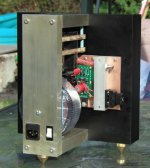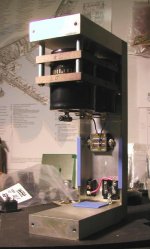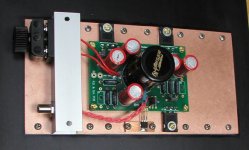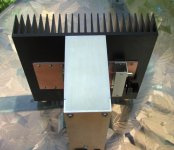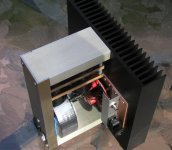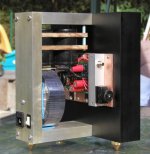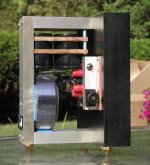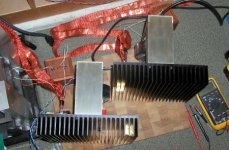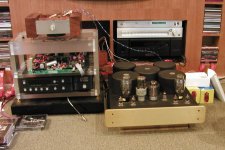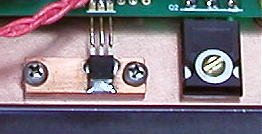Here's my version of Zv9:
It is a very good sounding amp.
It is a very good sounding amp.
Attachments
Last edited by a moderator:
Peter Daniel said:It is a very good sounding amp.
Looking nice.
What is the difference in sound compared with your gain clone?
I'm using the amps with Fertins 20 EX which are approx 100dB efficient. Zv9 has much less gain than GC, I can connect NOS DAC directly (2V ouptut) and the sound is about normal listening level.
I only had it on for few hours, so it's hard to draw any conclusions. First impression is that it sounds softer, with less bite and less edge. How desirable it becomes, I will write in a week or so. Beside that, tonality and detail are very similar.
BTW, I didn't switch from GC today, I had Dick Olsher's T-Rex 300B amp in my system last few days. It is a pretty good amp too.
I only had it on for few hours, so it's hard to draw any conclusions. First impression is that it sounds softer, with less bite and less edge. How desirable it becomes, I will write in a week or so. Beside that, tonality and detail are very similar.
BTW, I didn't switch from GC today, I had Dick Olsher's T-Rex 300B amp in my system last few days. It is a pretty good amp too.
Attachments
Looks good.
A few questions :
Did you solder the JFet?
Is that a copper plate that all the Fets are attached to?
Is there anything between the plate and the heatsink?
Alot of screws to attach the plate and I see you didn't use the PS board.
Simmonds
A few questions :
Did you solder the JFet?
Is that a copper plate that all the Fets are attached to?
Is there anything between the plate and the heatsink?
Alot of screws to attach the plate and I see you didn't use the PS board.
Simmonds
Yes, JFet was soldered to a small copper plate that is attached to the main plate.
The copper plate is 1/8" and acts as heat spreader/ heatsink damper. I used thermal grease to improve transfer.
PS board couldn't be used here, as it is designed for different caps.
The copper plate is 1/8" and acts as heat spreader/ heatsink damper. I used thermal grease to improve transfer.
PS board couldn't be used here, as it is designed for different caps.
Attachments
Looks like a very nice build. I have a couple of your boards and hope to have my ampilifier completed this winter. Once again thanks for making this hobby accessible to me. I have a couple of questions.
In the first photo it appears that resistors R1 and R6 were left out. I can understand R1 being left out so that a value can be selected later to obtain lowest distortion. However why is R6 left out?
What is the size of the heatsink? I am planning on a heatsink measuring 6" x 12" x 2.75" fin height for each channel, do you think this will be sufficent?
Thanks.
In the first photo it appears that resistors R1 and R6 were left out. I can understand R1 being left out so that a value can be selected later to obtain lowest distortion. However why is R6 left out?
What is the size of the heatsink? I am planning on a heatsink measuring 6" x 12" x 2.75" fin height for each channel, do you think this will be sufficent?
Thanks.
I was using 5W Mills resistors, so instead of 3 x 3W Panasonics I decided for 2 x 5W . The combined resistor value stays the same.
The heatsink is 11 x 11 x 2.25 . It is just about the right size. I used 300VA, 2 x 19V trafo and the actual voltage (with 0.27R resistor between caps) is 52V.
The heatsink is 11 x 11 x 2.25 . It is just about the right size. I used 300VA, 2 x 19V trafo and the actual voltage (with 0.27R resistor between caps) is 52V.
Thanks for sharing your implementation of this amp Peter. It's always
very interesting to see your ideas unfold into an amp.
I bet you were wondering if you'd ever get to use any of your R-Theta
heat sinks again!
Looking forward to the follow up in a few weeks.
Was the T-Rex amp your build, or a loaner? I don't think we've seen
how you'd build up a tube amp.
m.
very interesting to see your ideas unfold into an amp.
I bet you were wondering if you'd ever get to use any of your R-Theta
heat sinks again!
Looking forward to the follow up in a few weeks.
Was the T-Rex amp your build, or a loaner? I don't think we've seen
how you'd build up a tube amp.
m.
I try to use different approach to chassis building these days. Appearance is always secondary and form follows the function. If the idea of function is clearly defined, the form is not too bad either 😉
The transformer was initially intended to sit flat on a bottom bar, but it came too close to the circuit so I decided to mount it vertically.
T-Rex was built by someone else, but having the taste of 300B I will definitely build a tube amp myself as well. I still don't know which one though.
The transformer was initially intended to sit flat on a bottom bar, but it came too close to the circuit so I decided to mount it vertically.
T-Rex was built by someone else, but having the taste of 300B I will definitely build a tube amp myself as well. I still don't know which one though.
Beautiful build as always Peter. I must learn your secret of finding the time and money to build so prolifically. You've earned the same comment I made to Planet10 recently regarding his Frugel Horn developments:
Peter: Quit pressing my woo-woo button! I've got too many incomplete projects on the go already!
Seriously though, next time I'm in your part of the country I'll have to arrange a visit to your listening room.
Cheers, Terry
Peter: Quit pressing my woo-woo button! I've got too many incomplete projects on the go already!
Seriously though, next time I'm in your part of the country I'll have to arrange a visit to your listening room.
Cheers, Terry
Peter cheated this time;
he used U bar for connectors,instead of solid chunk of Alu!
Ugly!
Veeery ugly!
😉
he used U bar for connectors,instead of solid chunk of Alu!
Ugly!
Veeery ugly!
😉
Peter, those amps are looking incredibly good, indeed🙂
I had hoped for your oppinion on the nonpolar BG's versus film caps, hope you find time to get around to do a test.
Steen😎
I had hoped for your oppinion on the nonpolar BG's versus film caps, hope you find time to get around to do a test.
Steen😎
Thanks guys, especially to Mr. Pass for inspiration.
Steenoe,
I see no way to install 100uF film caps in place of BGs.
I did comparisons of films vs BG N in DAC coupling and I could only find one type of cap that was better in that particular application: it was teflon V-Cap, everything else (Jensen copper, MIT RTX, Hovland, Siemens MKV, Russian PIO, Woner Cap, Infini Cap) didn't perform how I like it. However, I was not looking for a sound that was impressive, but one that is true and convincing.
Steenoe,
I see no way to install 100uF film caps in place of BGs.
I did comparisons of films vs BG N in DAC coupling and I could only find one type of cap that was better in that particular application: it was teflon V-Cap, everything else (Jensen copper, MIT RTX, Hovland, Siemens MKV, Russian PIO, Woner Cap, Infini Cap) didn't perform how I like it. However, I was not looking for a sound that was impressive, but one that is true and convincing.
Ofcourse😀 I was thinking of the bypass caps😉 The 10 uF's🙂I see no way to install 100uF film caps in place of BGs.
Steen😎
You may find this post interesting then: http://www.diyaudio.com/forums/showthread.php?postid=491500#post491500
Peter,
How hot does the binding post and input RCA get? I noticed you didn't decouple the angle alluminum from the copper plate.
Did you source the copper plate from Metal Supermarket?
thanks,
m.
How hot does the binding post and input RCA get? I noticed you didn't decouple the angle alluminum from the copper plate.
Did you source the copper plate from Metal Supermarket?
thanks,
m.
Yes, the copper plate is from Metal Supermarkets.
I was also concerned with temp of aluminum angle, but because of small gauge it does not transfer heat well, so RCA and binding posts are only slightly warm.
I was also concerned with temp of aluminum angle, but because of small gauge it does not transfer heat well, so RCA and binding posts are only slightly warm.
- Status
- Not open for further replies.
- Home
- Amplifiers
- Pass Labs
- Another Zv9 completed
